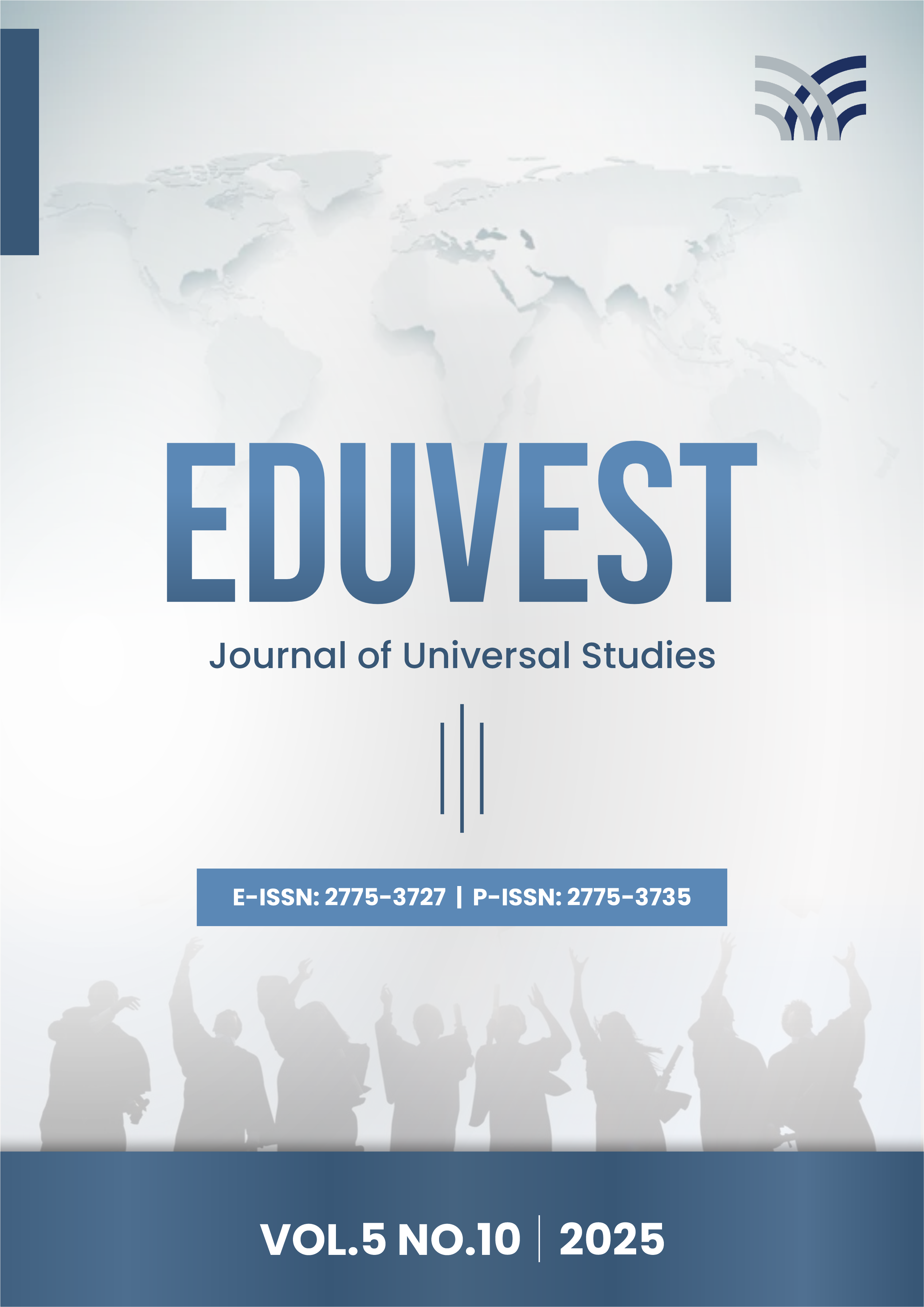The Importance of Nutritional Intake and Nutritional Status to the Adolescent Menstrual Cycle: A Systematic Literature Review
DOI:
https://doi.org/10.59188/eduvest.v5i10.51271Keywords:
menstrual cycle, nutritional status, nutritional intake, adolescentsAbstract
The menstrual cycle is the time between the beginning of menstruation in the previous period and the onset of the next period. One of the factors that affect the menstrual cycle is nutritional intake and nutritional status. This study aims to determine the importance of nutritional intake and nutritional status on the menstrual cycle in adolescents. This article uses a selection method based on the PRISMA (Preferred Reporting Items for Systematic Reviews and Meta-Analyses) diagram, in accordance with the inclusion criteria and predetermined keywords, and identified 10 articles to be analyzed. Based on the 10 articles analyzed, it was found that most show the importance of nutritional intake and nutritional status in affecting the regularity of the menstrual cycle. Several articles also demonstrate a relationship between both micro and macro nutritional intake and nutritional status on the menstrual cycle in adolescent girls. Nutritional intake and nutritional status play an important role in the regularity of adolescent menstrual cycles. These findings have important implications for public health policy, suggesting the need for comprehensive nutritional education programs targeting adolescent girls, healthcare providers, and educators. The evidence supports the development of school-based nutrition interventions and clinical guidelines for managing menstrual irregularities through nutritional approaches. Moreover, there is a clear relationship between nutritional intake and nutritional status and the menstrual cycle.
References
Amperaningsih, Y., & Fathia, N. (2019). The relationship between nutritional status and menstrual cycle in adolescents in Bandar Lampung. Scientific Journal of Nursing Science, 14(2), 194-199. DOI: https://doi.org/10.26630/jkep.v14i2.1306 Coal, J. R. (2016). Adolescent Development. Pediatrics, 12(1), 21. https://doi.org/10.14238/sp12.1.2010.21-9
Belayneh, Z., & Mekuriaw, B. (2019). Knowledge and menstrual hygiene practice among adolescent school girls in southern Ethiopia: A cross-sectional study. BMC Public Health, 19(1), 1–8. https://doi.org/10.1186/s12889-019-7973-9
Ciołek, A., Kostecka, M., Kostecka, J., Kawecka, P., & Popik-Samborska, M. (2024). An assessment of women's knowledge of the menstrual cycle and the influence of diet and adherence to dietary patterns on the alleviation or exacerbation of menstrual distress. Nutrients, 16(1), 69. https://doi.org/10.3390/nu16010069
Dars, S., Sayed, K., & Yousufzai, Z. (2014). Relationship of menstrual irregularities to BMI and nutritional status in adolescent girls. Pakistan Journal of Medical Sciences, 30(1), 141-144. https://doi.org/10.12669/pjms.301.3949
Fathia, N., & Amperaningsih, Y. (2018). The relationship between nutritional status and menstrual cycle in adolescents in Bandar Lampung. Scientific Journal of Pediatric Nursing, 14(2), 194–199.
Felicia, Hutagol, E., & Kundre, R. (2015). The Relationship between Nutritional Status and Menstrual Cycle in Adolescent Girls at PSIK FK UNSRAT Manado. Journal of Nursing, 3(1), 1–7.
Haripriya, S., Parker, K., Melson, E., Damerell, V., Ramos Salas, X., Kirk, A., ... & Jago, R. (2025). Adolescents, menstruation, and physical activity: insights from a global scoping review. BMC Women's Health, 25(1), 232. https://doi.org/10.1186/s12905-025-03825-w
Hidayah N, Rahfiludin MZ, Aruben R. The relationship between nutritional status, nutrient intake and physical activity with the menstrual cycle of adolescent girls of salafiyah Islamic boarding school kauman Pemalang Regency in 2016. Journal of Public Health 2016, 4(4): 537-444. DOI: https://doi.org/10.14710/jkm.v4i4.14284.
Hikmatun, K. D., Susan, Y., & Nurhaeni, A. (2023). The Importance of Nutritional Status in the Cycle Menstruation in Adolescents. Cikini Journal of Nursing, 4(2), 208–215.
Irianto, K. (2015). Reproductive Health. Jakarta: Alphabet.
Kapper, C., Oppelt, P., Ganhör, C., Gyunesh, A. A., Arbeithuber, B., Stelzl, P., ... & Rezk-Füreder, M. (2024). Minerals and the menstrual cycle: impacts on ovulation and endometrial health. Nutrients, 16(7), 1008. https://doi.org/10.3390/nu16071008
Mai Revi, Anggraini, W., & Warji. (2023). The Relationship between Nutritional Status and Menstrual Cycle in Senior High School Students. Medical Scholars: Journal of Stikes Al-Ma'arif Baturaja, 8(1), 123–131. https://doi.org/10.52235/cendekiamedika.v8i1. 219
Negi, P., Mishra, A., & Lakhera, P. (2018). Menstrual abnormalities and their association with lifestyle pattern in adolescent girls of Garhwal, India. Journal of Family Medicine and Primary Care, 7(4), 804-808. https://doi.org/10.4103/jfmpc.jfmpc_159_17
Rakhmawati, A., & Fithra Dieny, F. (2013). Young Adult Women. Journal of Nutrition College, 2(1), 214–222. http://ejournal- s1.undip.ac.id/index.php/jnc
Revi, M., Anggraini, W., Warji. (2023). The Relationship between Nutritional Status and Menstrual Cycle in Senior High School Students. Medical Scholars: Stikes Al-Maarif Baturaja Journal, 8(1), 123-131. https://doi.org/10.52235/cendekiamedika.v8i1. 219
Roro Sekar Arum, V., Yuniastuti, A., Woro Kasmini, O., & Diponegoro, J. (2019). The Relationship of Nutritional Status, Physical Activity, Stress, and Menarche to Menstrual Disorder (Oligomenorrhea). Public Health Perspectives Journal, 4(1), 37–47. http://journal.unnes.ac.id/sju/index.php/phpj
Sen, L. C., Rahman, M. M., Harun, G. D., Moniruzzaman, M., Sultana, N., Begum, A., ... & Akter, S. (2024). Food craving, vitamin A, and menstrual disorders: A comprehensive study on university female students. Food Science & Nutrition, 12(7), 4819-4831. https://doi.org/10.1002/fsn3.4128
Simarmata, V. P. A., Dhar, D., Timung, N. T., & Bharali, A. (2023). Influence of lifestyle factors with the outcome of menstrual disorders among adolescents and young women in West Bengal, India. Scientific Reports, 13(1), 13307. https://doi.org/10.1038/s41598-023-35858-2
Supatmi, Yusliana, A., W, Y., & Ly, F. (2018). Lecturer at the Faculty of Health Sciences, University of Muhammadiyah Surabaya, Student of the Faculty of Health Sciences, University of Muhammadiyah Surabaya. Journal of Midwifery, 1(1), 14–20.
Tetty Rihardini. (2019). Regulations, Recognizing Menstruation, Cycle Disorders, Detecting Reproduction, Health In, Mountain Teenagers, Tambak Village, Anyar. 266–274.
Downloads
Published
How to Cite
Issue
Section
License
Copyright (c) 2025 Syahla Rizki Alifiya, Nagita Vicilya Utami, Arih Diyaning Intiasari, Eri Wahyuningsih

This work is licensed under a Creative Commons Attribution-ShareAlike 4.0 International License.











